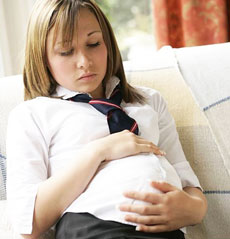fitness news


Font size Fertility & Pregnancy
Teen Mothers Have Higher Rate of Vaginal Births
– Reported, May 13, 2012

Among a million pregnancies in a single state’s perinatal dataset, the rate of vaginal delivery for women under 16 was 82.7% compared with a rate of 71.6% for women ages 16 to 35 (P=0.001), reported Dimitrios Mastrogiannis, MD, PhD, from Temple University School of Medicine in Philadelphia, and colleagues in a presentation at the annual meeting of the American College of Obstetricians and Gynecologists.
In general, teenage pregnancy is on the decline in the U.S., at 39.1 per 1,000 in 2009 versus 41.5 per 1,000 in 2008. But the U.S. rate remains higher than the rate in most industrialized nations, the authors stated.
The investigators noted that data are few on pregnancy outcomes in mothers younger than 16, despite information that obstetrical complication rates are higher. There are also conflicting data on vaginal delivery rates versus cesarean section in this population.
The authors evaluated a New Jersey perinatal dataset, for the years 1997 through 2005, with a little over 1 million pregnancies. Among those, 0.5% were in patients younger than 16 and 86% were in patients between ages 16 and 35.
In addition to a higher vaginal delivery rate compared with the older cohort, younger women were more likely to have the following (P=0.001 for all):
Smaller babies, 3,079 g versus 3,306 g
More premature births, 15% versus 9.8%
More preeclampsia, 3.2% versus 2.1%
Less gestational diabetes, 0.1% versus 2.1%
Longer labors, 12.4 hours versus 9.2 hours
The authors also found that the younger mothers had their first prenatal visit at 4.1 months compared with 2.7 months for the older teens and adults (P=0.001), and that the younger girls had fewer prenatal visits (11.89) compared with the older group (13.59, P=0.001).
The babies of the younger girls also spent about 1 day longer (4.6 days) in the hospital compared with the babies of the older group (3.6 days, P=0.001).
The differences in delivery rates between the two groups (more vaginal deliveries, fewer c-section deliveries) remained after correction for gestational age and birth weight at delivery, the group stated. Mastrogiannis speculated that the lower rate of c-section among the younger girls might be because they were still maturing physically and their ligaments could be more flexible.
However, he noted that increased blood loss during delivery was seen for the younger mothers, at 661.7 mL versus 576.3 mL in the older mothers (P=0.001). “The increased blood loss at delivery could be associated with increased perineal trauma or more coagulation abnormalities in the younger group,” Mastrogiannis suggested.
“What we can’t determine from this dataset is how children who are having children respond psychologically to their pregnancies and young motherhood,” he said.
Primary source: American College of Obstetricians and Gynecologists
Source reference:
Mastrogiannis D, et al “Are there more obstetrical complications associated with teenage (younger than 16 years) pregnancy?” ACOG 2012.